Selection of Ottoman Turkey,Iznik and Kutahya pottery @ Christie's
An Iznik pottery tile panel, Ottoman Turkey, circa 1575. Photo Christie's Image Ltd 2010
Composed of twelve square tiles, the surface decorated in cobalt- blue, turquoise, green, brown and bole red with an overall design of columns of alternating circular and ogival medallions each outlined in red, the circular medallions containing a design of tulips and carnations issuing from a central rosette reserved against blue ground and the ogival medallions with a central tulip flanked by hyacinth sprays, dividing by branches bearing serrated vine leaves and issuing tendrils with bunches of grapes, repaired breaks and significant areas of repainting, mounted and framed - 29½ x 38½in. (74.5 x 97.8cm.) - Estimate £60,000 - £80,000
Provenance: Sotheby's, 13 April 1988, lot 348
Notes: Only two other tiles with this design are known. One is in the Isabella Stewart Gardner Museum (http://www.gardnermuseum.org/collection/tile_c7w3.asp) and the other is said to be in the Art Club, Providence, Rhode Island.
Although it has no exact parallels, the ogival lattice of this tile panel is similar in visual impact to a slightly earlier one on the interior of the Mosque of Rüstem Pasha, circa 1560 (Walter Denny, Gardens of Paradise. 16th Century Turkish Ceramic Tile Decoration, Turkey, 1998, pl. 10, pp. 36-37). The oval medallions, each framing a single bold red tulip create a similar powerful effect in each. The main difference comes that the medallions in the Rüstem Pasha example are framed with cloud bands whilst those in the present are alternated with circular medallions and undulating vine.
Ottoman art is no stranger to the ogival lattice. It is perhaps most commonly encountered in kemha weaving. Indeed in that medium, similar lattices with large tulip decoration are found. See for example, Nurhan Atasoy, Walter B. Denny, Louise W. Mackie and Hülya Tezcan, Ipek. The Crescent and the Rose. Imperial Ottoman Silks and Velvets, London, 2001, pp. 276-77. Other motifs from the present tile panel can also be echoed in Ottoman textiles. The fleshy serrated vine leaves with seven main points find a parallel in a velvet in the Freer Gallery of Art , dated circa 1600 (Yanni Petsopoulos (ed.), Tulips, Arabesques and Turbans, London, 1982, no. 132, p. 140). Similarly the circular medallions containing tulips and carnations issuing from a central rosette are found in a kemha of the second half of the 16th century in the Musée de la Mode et du Textile, Union Centrale des Art Décoratifs, Paris (inv. no. 18312, Atasoy et al, op. cit., 2001, p. 185).
An Iznik blue and white pottery bottle base. Ottoman Turkey, circa 1510. Photo Christie's Image Ltd 2010
Rising from short foot through drop-shaped body to tapering neck, the body decorated with a white strapwork lattice terminating at the neck with vertical points, around the body the lattice forming ogival motifs each with a floral spray on blue ground, around the foot a band of elaborate paired cloud-motifs on white ground, cut at the neck, with small drill holes around the neck, foot slightly chipped - 10¾in. (27.4cm.) high - Estimate £50,000 - £70,000
Notes: "Sometime towards the end of the 15th-century Ottoman potters started manufacturing blue-and-white ceramics of a technical standard unmatched in the Muslim world since the early thirteenth century pottery of Kashan. The vessels, often of impressive size, had a hard, dense fritware body covered with a brilliant white slip, onto which were painted elaborate arabesques and floral scrolls in a rich cobalt which had depth and texture - the 'heap and piled' effect - of the first Yuan blue-and-white porcelains from China. Over this was a compact, colourless glaze which adhered tightly to the body and showed no flaws of crackle and tendency to pool". Thus Julian Raby introduces the highly innovative wares that began to be made at Iznik at this time (Nurhan Atasoy and Julian Raby, Iznik, the Pottery of Ottoman Turkey, London, 1989, p.77). His summary of the developments that took place at Iznik clearly acknowledges the debt to previous scholars, notably Arthur Lane who in 1957 was the first to put stricter rigour into the chronology of the development of Iznik pottery (Arthur Lane, "Ottoman Pottery of Isnik", Ars Orientalis, vol.II, 1957, pp.247-281). It was Lane who first differentiated between the different early blue and white vessels, establishing a progression in style and execution.
The earliest "heaped and piled" blue was replaced at around the turn of the 15th/16th century by a more even tone. The early motifs, whose original invention is credited to Baba Nakkash, became somewhat looser in drawing and the compositions more open in the early years of the 16th century. Dating is provided by the tiles used in the tomb of Sehzade Mahmud, dating from 1506-7, which exemplify the new slightly changed aesthetic. (Atasoy and Raby, op.cit., pls.81 and 82, pp.90-91). Further comparable elements can be found between the present bottle and a group of mosque lamps, now divided between the British Museum and the Çinili Kösk that are associated with the tomb chamber of Sultan Bayezid II which was probably completed shortly after his death in 1512. The small floral motifs are very similar indeed, particularly to those running in vertical panels up the necks of two of the lamps, and the depth of the blue is very comparable. The trefoil panels at the base of the body are also similar, albeit not as refined, as the panels around one mosque lamp formerly in the Godman Collection (Atasoy and Raby, op.cit, pl.288). One final comparable in terms of the decoration is shown by the cloudbands around the base, probably the strongest drawn element of all on this bottle. These, with their swirling feathery extensions are very similar to the cloudband motifs on the rim of a very powerful dish formerly in the Pharaon Collection in Beirut (Atasoy and Raby, op.cit, pl.291), now in the Sadberk Hanim Museum, Istanbul.
While the floral motifs and the details of drawing relate closely to known examples, the lattice of strapwork seen on the present bottle base is without parallel in early Iznik wares. Before the publication of the present bottle, the earliest example of the form, again missing the neck, formerly in the Homaizi Collection and now in the Museum of Islamic Art, Doha was dated to 1520-25 (Atasoy and Raby, op.cit., pl.304; John Carswell, Iznik Pottery for the Ottoman Empire, Doha and London 2003, no.2, pp.26-7). The present bottle demonstrates that this shape was produced during the early phases of pottery at Iznik, a shape that was developed into one of the most typical of all Iznik vessels.
An Iznik pottery dish. Ottoman Turkey, circa 1575. Photo Christie's Image Ltd 2010
With sloping rim on short foot, the white interior painted under the glaze in bole-red, cobalt-blue, green and black with a symmetric arrangement comprising a floral spray with red flowerheads, carnations and blue saz leaves flanking a central red palemtte, the border with stylised wave and rock design within blue cusped border, the exterior with alternating paired blue tulips and green flowerheads and a similar blue cusped band around the rim, foot and rim drilled - 11 3/8in. (28.9cm.) diam. - Estimate £15,000 - £20,000
An Iznik pottery dish. Ottoman Turkey, circa 1590. Photo Christie's Image Ltd 2010
With sloping rim on short foot, the white ground painted in cobalt blue, bole-red, green and black under the glaze with strong central rosette design with white petals radiating from a polychrome centre, the cavetto with stylised wave design, the rim with stylised wave and rock motif, the reverse plain, foot drilled - 12 1/8in. (30.8cm.) diam. - Estimate £15,000 - £20,000
An Iznik pottery jug, Ottoman Turkey, circa 1560. Photo Christie's Image Ltd 2010
Of baluster form with short foot rising to flaring mouth and with simple loop handle, the white body decorated with cobalt-blue, green, red and black under the glaze with alternating branches of red flowerheads and blue saz leaves, a similar but reduced pattern on the neck, a short band of black S-shapes around the neck and a band of white trilobed motifs with red centres around the mouth, slight restoration to rim and foot - 9 5/8in. (24.5cm.) high - Estimate £15,000 - £20,000
Provenance: Sotheby's, 11 October 1990, lot 479
Notes: Like the Girton College water bottle (surahi) sold in these Rooms, 24 April 1990, lot 386 and the Iznik jug with ships that was offered in these Rooms, 7 October 2008, lot 424, this jug is very thinly potted.
An Iznik pottery dish. Ottoman Turkey, circa 1580. Photo Christie's Image Ltd 2010
With sloping rim on short foot, the white interior painted in green, cobalt-blue, bole-red and black with a fine floral spray composed of a central group of carnations, flanked by two small tulips and sprays of blue flowerheads, the border with stylised wave and rock, the exterior with alternating green flowerheads and paired tulips, foot and rim drilled, otherwise intact, the base with a number of old owners' stamps - 10½in. (26.8cm.) diam. - Estimate £10,000 - £15,000
An Iznik pottery tile panel, Ottoman Turkey, circa 1575. Photo Christie's Image Ltd 2010
Of rectangular form, the white ground painted under the glaze with two thick vine stems emerging from the lower edge issuing curling tendrils, bold blue and red flowerheads, a delicate vine leaf and a bunch of grapes, two sides reduced - 9¾ x 7¾in. (24.5 x 19.5cm.) - Estimate £8,000 - £10,000
Notes: Similar branches of prunus to those found here are a relatively common feature in Iznik pottery. They are found, for example, in two large panels in the Mosque of Rüstem Pasha (see Fatih Cimok (ed.), The Book of Rüstem Pasha Tiles, Istanbul, 1999, p. 12) and flanking the entrance to the tomb of Selim II (one panel of which is now in the Louvre (OA3919/2-265)). It is the combination of the prunus branch with vine makes this tile more unusual.
Tiles with this combination can however be found decorating the walls to the left of a window in the eastern corner of the Takkeci Ibrahim Aga Mosque in Istanbul (Oktay Aslanapa, Türkische Fliesen und Keramik in Anatolien, Istanbul, 1965, Abb. 51 or Walter Denny, Gardens of Paradise, Turkey, 1998, pl.99, p.176). Two other similar tile panels are in the Istanbul Archaeological Museum (41/502, Nurhan Atasoy, Splendors of the Ottoman Sultans, Memphis, 1992, p. 154) and in the Topkapi Palace (Çinili Kök 41/502, Esin Atil (trans.), The Anatolian Civilisations III (exhibition catalogue), Istanbul, 1983, no. E.171, p. 209). The composition of those tiles echo ours precisely, but in the use of the manganese in the grapes and branches and in the red dashes within the vines, the present tile differs.
Another feature in which our tile varies from the others is in the small prunus flowers. The petals of all of the above are lobed, whereas those of ours are smooth, similar to those used in a different compositional context in a series of tiles of which panels exist in the David Collection, the Collection of Edwin Binney 3rd , the Louvre and the Museum of Islamic Art in Cairo (41/1968, Kjeld von Folsach, Art from the World of Islam in the David Collection, Copenhagen, 2001, no. 278, p.193 and Walter B. Denny, Turkish Treasures from the Collection of Edwin Binney, 3rd, exhibition catalogue, Oregon, 1979, no. 9, pp.216-217). These were made for the Mosque of Eyüp, probably under Sultan Murad III towards the end of the 16th century. Another feature shared by those and the present tile is the unusual dark manganese purple which here we for the stems of the prunus branch, and which again is hard to parallel elsewhere.
An Iznik pottery dish. Ottoman Turkey, circa 1600. Photo Christie's Image Ltd 2010
With sloping rim on short foot, the white interior painted in cobalt- blue, bole-red, green and black with a design centred on a quatrefoil rosette from which issue curving saz leaves, tulips and carnations, the rim with design of alternating paired tulips and flowerheads, the reverse with alternating blue roundels and green leaves, foot drilled, minor chips to rim - 10¼in. (26cm.) diam. - Estimate £8,000 - £12,000
An Iznik pottery dish. Ottoman Turkey, circa 1590. Photo Christie's Image Ltd 2010
Of rounded form on short foot, the white interior painted under the glaze in bole-red, cobalt-blue, green and black with a central rosette on blue ground from which radiates a series of red arabesques forming a medallion and containing small blue flowerheads on scrolling vine, the border with repeating trilobed motifs on blue ground, the reverse with alternating blue flowerheads and small floral sprays, repaired breaks - 12 1/8in. (30.9cm.) diam. Estimate £8,000 - £10,000
Three Iznik turquoise, blue and white pottery tiles, Ottoman Turkey, circa 1530. Photo Christie's Image Ltd 2010
Each with spiralling tendrils issuing sickle-shaped leaves on white ground, each leaf containing further elongated palmettes in cobalt-blue on turquoise-blue ground, with cusped border on blue ground along top, one tile with two corners restored, slight abrasion. Each 7¾ x 5¼in. (19.8 x 13.3cm.) - Estimate £7,000 - £10,000
A Kutahya pottery coffee pot. Ottoman Turkey, 18th century. Photo Christie's Image Ltd 2010
With rounded body and sloping shoulder, on short flat foot, the tall straight neck rising from a slightly raised ring above the shoulder, with everted squared spout, the loop handle joining the body to the neck, with domed lid hinged to the neck, decorated with alternating red and yellow medallions with palmettes and further polychrome floral sprays, maker's mark under the foot, minor chips, knop a later replacement, foot repaired - 6 1/8in. (15.5cm.) high - Estimate £7,000 - £10,000
Notes: This coffee pot bears close resemblance to one in the Keir Collection that was formerly in the Adda Collection (Oliver Watson in B.W. Robinson et al, Islamic Art in the Keir Collection, London, 1988, C.105, pl. 59, p.247, published also in Bernard Rackham, Islamic Pottery and Italian Maiolica, London, 1959, no.229, p.53). Another similar ewer sold in these Rooms, 12 October 1999, lot 394.
A rimless Iznik pottery dish. Ottoman Turkey, circa 1600. Photo Christie's Image Ltd 2010
With rounded sides on short foot, the white ground painted in bole-red, green, cobalt-blue and black under the glaze with a central design on green ground of radiating and rotating arabesques forming a central medallion and spiralling outwards, with small blue circles in the intersticies, within a minor band of cusped motifs, the cavetto with a band of white lobes against blue ground, the exterior with alternating blue and green motifs, varnish on the surface, rim built up, foot drilled - 10 7/8in. (28cm.) diam. Estimate £5,000 - £8,000
Notes: The central design of radial or rotational arabesques found on this dish derives from earlier Iznik blue and white prototypes. Those in turn were influenced by the silver designs of the period of Bayezid II (generally attributed to the Balkans). For examples of similar designs used in both of these contexts see Iznik, The Pottery of Ottoman Turkey (Nurhan Atasoy and Julian Raby, London, 1989, nos. 55-58 and 61-62, p.78 and 80).
A Kutahya pottery ewer and cover. West Anatolia, 19th century. Photo Christie's Image Ltd 2010
Rising through short foot to rounded body with spiral fluted sides through pronounced collar to tubular neck from which a short spout rises, elaborately curving handle attaching body and neck, with separate domed lid with faceted sides and knop finial, the surfaces decorated in red, green, blue, turquoise and manganese with repeating floral sprays, the neck with two cartouches with white calligraphy reserved against blue ground, blue maker's mark on the foot, one hole to body - 15½in. (39.5cm.) high - Estimate £5,000 - £7,000
Notes: The Turkish inscription around the neck of this ewer is a Turkish couplet which reads içilmez mi elinden su , getürmi-i bir keman abru (Who could refuse to drink water brought by such an arched eyebrow?). The same inscription is found on a ewer in the collection of the Foundation of Suna and Inan Kiraç (illustrated in Garo Kürkman, Magic of Clay and Fire, A History of Kütahya Pottery and Potters, Turkey, 2006, Figs.295-298, pp.228-229).
Two Iznik pottery tile panel, Ottoman Turkey, circa 1600. Photo Christie's Image Ltd 2010
Each with a design of scrolling cobalt-blue vine with feathery green saz leaves, a string of small rosettes to their centre, large composite half flowers along the edges and two quarters of a cusped medallion on turquoise blue ground in the corners, two of these forming a half medallion, one tile intact, the other with repaired breaks, chips to the edges - Panel 10½ x 20¾in. (26.7 x 52.8cm.) Estimate £4,000 - £6,000
Provenance: French private collection, since 1895
An Iznik pottery tile panel, Ottoman Turkey, circa 1585. Photo Christie's Image Ltd 2010
The white ground with a central red, green and blue rosette issuing six swirling branches each with a similar smaller rosette, also with the addition of a turquoise colour, set within a cusped red and white circular frame, the linked green spandrels with reserved white, red and blue arabesque panels, slight chipping to edges - 9¾in. (24.5cm.) square - Estimate £4,000 - £6,000
Notes: Tiles of this design are used to surround the mihrab in the Mesih Mehmet Pascha Mosque dating from 1585. This mosque, whose patron was briefly Grand Vizier under Sultan Murad III, was built in 1585. Other examples of the design are in the Sadberk Hanim Museum (Ara Altun, John Carswell and Gönül Öney, Turkish Tiles and Ceramics, Istanbul, 1985, no.I.71, p.44), the Hetjens Museum, Düsseldorf (J. Zick-Nissen, Islamische Keramik, exhibition catalogue, Düsseldorf, 1973, no.345, pp.235-6) and other collections. Others have sold in these Rooms, 12 October 2004, lot 27. For another tile from the same series please see the following lot.
A Kutahya pottery rose water sprinker (Gulebtan). Ottoman Turkey, 18th century. Photo Christie's Image Ltd 2010
With rounded body rising from a short flat foot to a long tapering neck, the body moulded with six almond-shaped medallions with stylized palmettes, the delicately painted decoration with sprays of turquoise and cobalt-blue tulips outlined with black, with six floral scrolls above the foot and a band of thin leaves around the spout, foot partly unglazed, intact - 7in. (17.7cm.) high - Estimate £4,000 - £6,000
Christie's. Art of the Islamic and Indian Worlds. 13 April 2010. London, King Street www.christies.com

/https%3A%2F%2Fprofilepics.canalblog.com%2Fprofilepics%2F1%2F0%2F100183.jpg)


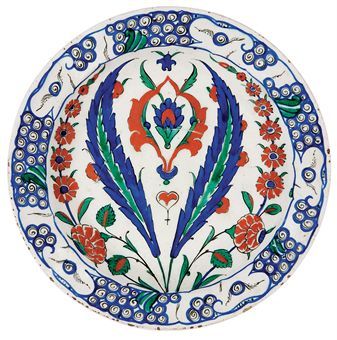


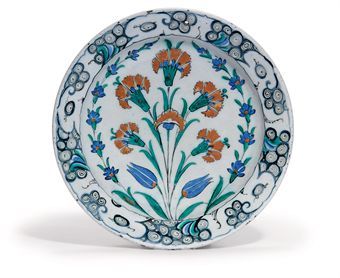


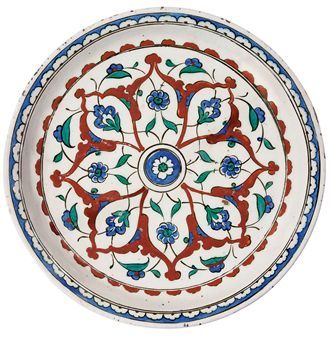
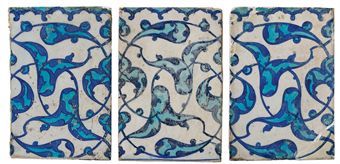




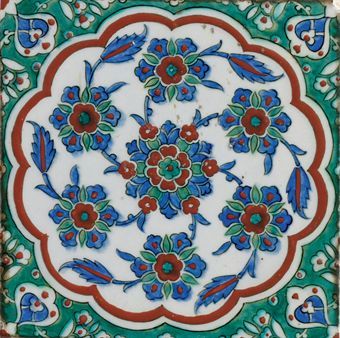



/http%3A%2F%2Fstorage.canalblog.com%2F54%2F28%2F577050%2F66207373_o.jpg)
/http%3A%2F%2Fstorage.canalblog.com%2F38%2F35%2F577050%2F66167687_o.jpg)
/http%3A%2F%2Fstorage.canalblog.com%2F77%2F77%2F577050%2F66151319_o.jpg)
/http%3A%2F%2Fstorage.canalblog.com%2F71%2F09%2F119589%2F66118115_p.jpg)